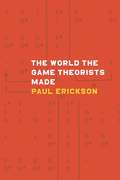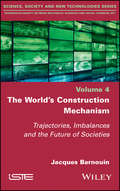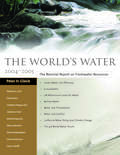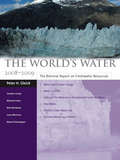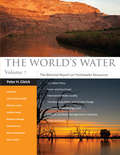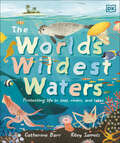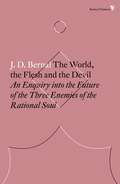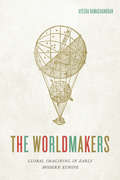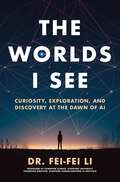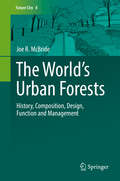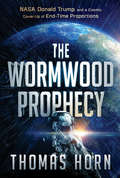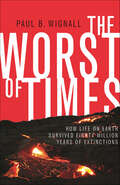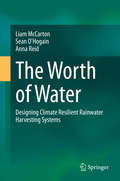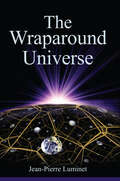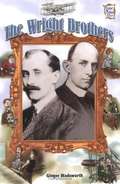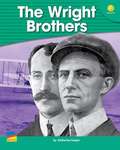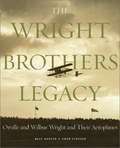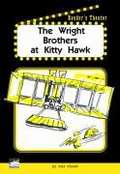- Table View
- List View
The World of the Beaver
by Leonard Lee Rue III"According to a Cherokee legend," writes Leonard Lee Rue in The World of the Beaver, "it was the Great Spirit, with the help of gigantic beavers, who created the earth. The earth had been covered with water until the Great Spirit sent the beavers diving down beneath the surface to dredge up mud from the bottom to form land masses." Although the beaver is not, nowadays, as big as his legendary ancestors, he continues to be enormously helpful to man and beast. Here Leonard Lee Rue reveals the world and way of life of the good -natured, industrious American beaver and follows him through a full year of his ordinary activities. How does a beaver fell a tree? What does he eat? Is he polygamous or monogamous? How does he build a dam? What does the inside of his lodge look like? Who has been his most deadly enemy in America? The author-whose interest in beavers has caused him to go swimming with them and, on one occasion, led to his becoming stuck in the passage to a lodge-answers all these questions and many others. The informal narrative and the author's remarkable photographs make this really first-rate reading for the nature student and for the ordinary reader. "As intent as man seems to be on destroying the earth," writes Leonard Lee Rue in conclusion, "the Creator may again have to call upon the beavers to help patch things up. The earth's future couldn't be in better paws."
The World of the Gull (A Living World Book)
by David F. CostelloThe world of the gull extends from the barren Arctic wastes to the burning sands of Arabia, from the storm clouds of Tierra del Fuego to the farmlands of our own Great Plains. Equipped with extraordinary flying ability, intelligence, and an enviable digestion, gulls lead strange and wonderful lives. Born opportunists, they are completely adaptable, self-sufficient creatures, equally at home on land or sea-one of the few members of the animal kingdom able to drink both fresh and salt water. Unlike most other birds, gulls walk, fly, and swim with ease. These capabilities put them in touch with an unlimited variety of food-from cherries, mice, brine fly larvae, wheat, and steak bones to eggs, worms, and young ducks-and make them one of nature's most valuable scavengers. David Costello describes all aspects of the gulls' life cycle-their ritualistic courtship and nesting habits, the rearing of their young, colony formation, food finding, natural enemies, and their remarkable migrations over the face of the earth.
The World of the Otter (Living World Book)
by Ed ParkEver wondered how those otters on the river bank are so playful, what do they eat, where do they live, how do they survive the winter? In this book by naturalist Ed Park, who has studied otters for years, you will find the answers to these questions and get to know the clowns of the river bank more closely.
The World the Game Theorists Made
by Paul EricksonIn recent decades game theory—the mathematics of rational decision-making by interacting individuals—has assumed a central place in our understanding of capitalist markets, the evolution of social behavior in animals, and even the ethics of altruism and fairness in human beings. With game theory’s ubiquity, however, has come a great deal of misunderstanding. Critics of the contemporary social sciences view it as part of an unwelcome trend toward the marginalization of historicist and interpretive styles of inquiry, and many accuse its proponents of presenting a thin and empirically dubious view of human choice. The World the Game Theorists Made seeks to explain the ascendency of game theory, focusing on the poorly understood period between the publication of John von Neumann and Oscar Morgenstern’s seminal Theory of Games and Economic Behavior in 1944 and the theory’s revival in economics in the 1980s. Drawing on a diverse collection of institutional archives, personal correspondence and papers, and interviews, Paul Erickson shows how game theory offered social scientists, biologists, military strategists, and others a common, flexible language that could facilitate wide-ranging thought and debate on some of the most critical issues of the day.
The World the Game Theorists Made
by Paul EriksonIn recent decades game theory--the mathematics of rational decision-making by interacting individuals--has assumed a central place in our understanding of capitalist markets, the evolution of social behavior in animals, and even the ethics of altruism and fairness in human beings. With game theory's ubiquity, however, has come a great deal of misunderstanding. Critics of the contemporary social sciences view it as part of an unwelcome trend toward the marginalization of historicist and interpretive styles of inquiry, and many accuse its proponents of presenting a thin and empirically dubious view of human choice. The World the Game Theorists Made seeks to explain the ascendency of game theory, focusing on the poorly understood period between the publication of John von Neumann and Oscar Morgenstern's seminal Theory of Games and Economic Behavior in 1944 and the theory's revival in economics in the 1980s. Drawing on a diverse collection of institutional archives, personal correspondence and papers, and interviews, Paul Erickson shows how game theory offered social scientists, biologists, military strategists, and others a common, flexible language that could facilitate wide-ranging thought and debate on some of the most critical issues of the day.
The World's Construction Mechanism: Trajectories, Imbalances, and the Future of Societies
by Jacques BarnouinThe interdisciplinarity between the biological and human sciences is here to serve a daring objective: to decipher, by means of a logical chain, the explanatory factors of human trajectories and imbalances between societies and nations. To do this, The World’s Construction Mechanism is based on an unprecedented analysis of the dynamics of the human species, combining the contributions of anthropology, archeology, biology, climatology, economics, geography, history and sociology. This book analyzes the roots of societal disharmony and presents ways of realizing a clear-sighted human project that is in step with the general interest of humanity.
The World's Water 2004-2005: The Biennial Report on Freshwater Resources (The World's Water)
by Peter H. Gleick Pacific Institute Catherine Hunt Dana Haasz Nicholas L. Cain Christine Henges-JeckThe quality and availability of fresh water are of critical importance to human and ecosystem health. Given its central role in the functioning of all living systems, water is arguably the most important of all natural resources. Produced biennially, The World's Water provides a timely examination of the key issues surrounding freshwater resources and their use. Each new volume identifies and explains the most significant current trends worldwide, and offers the best data available on a variety of water-related topics. This 2004-2005 edition of The World's Water features overview chapters on: conservation and efficiency as key tools for meeting freshwater needs; bottled water quality, costs, and trends; United Nations millennium development goals; groundwater issues; case studies of water privatization; the economic value of water; California water policy and climate change. The World's Water is the most comprehensive and up-to-date source of information and analysis on freshwater resources and the political, economic, scientific, and technological issues associated with them. It is an essential reference for water resource professionals in government agencies and nongovernmental organizations, researchers, students, and anyone concerned with water and its use.
The World's Water 2006-2007: The Biennial Report on Freshwater Resources (The World's Water)
by Peter H. Gleick Heather Cooley Meena Palaniappan Andrea Samulon Gary H. Wolff Emily LeeProduced biennially, The World's Water provides a timely examination of the key issues surrounding freshwater resources and their use. Each new volume identifies and explains the most significant current trends worldwide, and offers the best data available on a variety of water-related topics. The 2006-2007 volume features overview chapters on: *Water and terrorism *Business risks of water *Water and ecosystems *Floods and droughts *Desalination *Environmental justice and water The book contains an updated chronology of global conflicts associated with water as well as an assessment of recent water conferences, including the 4th World Water Forum. It also offers a brief review of issues surrounding the use of bottled water and the possible existence of water on Mars. From one of the world's leading authorities on water issues, The World's Water is the most comprehensive and up-to-date source of information and analysis on freshwater resources and the political, economic, scientific, and technological issues associated with them.
The World's Water 2008-2009: The Biennial Report on Freshwater Resources (The World's Water)
by Peter H. Gleick Heather Cooley Meena Palaniappan Jason Morrison Mari Morikawa Michael J. CohenProduced biennially, The World's Water provides a timely examination of the key issues surrounding freshwater resources and their use. Each new volume identifies and explains the most significant trends worldwide, and offers the best data available on a variety of topics related to water. The 2008-2009 volume features overview chapters on: * water and climate change * water in China * status of the Millennium Development Goals for water * peak water * efficient urban water use * business reporting on water This new volume contains an updated chronology of global conflicts associated with water, as well as brief reviews of issues regarding desalination, the Salton Sea, and the Three Gorges Dam. From the world's leading authority on water issues, The World's Water is the most comprehensive and up-to-date source of information and analysis on freshwater resources and the political, economic, scientific, and technological issues associated with them. It is an essential reference for water resource professionals in government agencies and nongovernmental organizations, researchers, students, and anyone concerned with water and its use.
The World's Water Volume 7: The Biennial Report on Freshwater Resources (The World's Water)
by Peter H. Gleick Heather Cooley Michael J. Cohen Lucy Allen Juliet Christian-Smith Matthew HebergerProduced biennially, The World's Water is the most comprehensive and up-to-to date source of information and analysis on freshwater resources. Each new volume examines critical global trends and offers the best data available on a variety of topics related to water. Volume 7 features chapters on U.S. water policy, transboundary waters, and the effects of fossil fuel production on water resources, among other timely issues. Water briefs provide concise updates on topics including bottled water, The Great Lakes Water Agreement, and water and security. The World's Water is coauthored by MacArthur "genius" Peter H. Gleick and his colleagues at the world-renowned Pacific Institute. Since the first volume was published in 1998, the series has become an indispensable resource for professionals in government agencies and nongovernmental organizations, researchers, students, and anyone concerned with water and its use.
The World's Wildest Waters: Protecting Life in Seas, Rivers, and Lakes
by Catherine BarrA beautifully presented entry point text about our oceans and other watery worlds for 6 years and upDive into the world&’s wildest oceans, lakes, and rivers, and get ready for an underwater adventure!Embark on the journey of a lifetime to 20 of the world&’s wildest waters! Explore each environment and learn about the people who are working to preserve them for future generations. Meet the creatures who call these watery worlds home and discover how you can take active steps to make a difference. Featuring colorful original illustrations and stunning photography, The World&’s Wildest Waters brings the excitement of the high seas and the mystery of the ocean&’s dark, hidden depths to your lap.
The World, the Flesh and the Devil: An Enquiry into the Future of the Three Enemies of the Rational Soul
by J. D. BernalA pioneering book proposing a transhumanist vision of the future, from one of the most influential visionary scientists of the twentieth century.
The World-Time Parallel: Tense and Modality in Logic and Metaphysics
by A. A. Rini M. J CresswellIs what could have happened but never did as real as what did happen? What did happen, but isn't happening now, happened at another time. Analogously, one can say that what could have happened happens in another possible world. Whatever their views about the reality of such things as possible worlds, philosophers need to take this analogy seriously. Adriane Rini and Max Cresswell exhibit, in an easy step-by-step manner, the logical structure of temporal and modal discourse, and show that every temporal construction has an exact parallel that requires a language that can refer to worlds, and vice versa. They make precise, in a way which can be articulated and tested, the claim that the parallel is at work behind even ordinary talk about time and modality. The book gives metaphysicians a sturdy framework for the investigation of time and modality – one that does not presuppose any particular metaphysical view.
The Worldmakers: Global Imagining in Early Modern Europe
by Ayesha RamachandranIn this beautifully conceived book, Ayesha Ramachandran reconstructs the imaginative struggles of early modern artists, philosophers, and writers to make sense of something that we take for granted: the world, imagined as a whole. Once a new, exciting, and frightening concept, "the world" was transformed in the sixteenth and seventeenth centuries. But how could one envision something that no one had ever seen in its totality? The Worldmakers moves beyond histories of globalization to explore how "the world" itself--variously understood as an object of inquiry, a comprehensive category, and a system of order--was self-consciously shaped by human agents. Gathering an international cast of characters, from Dutch cartographers and French philosophers to Portuguese and English poets, Ramachandran describes a history of firsts: the first world atlas, the first global epic, the first modern attempt to develop a systematic natural philosophy--all part of an effort by early modern thinkers to capture "the world" on the page.
The Worlds I See: Curiosity, Exploration, and Discovery at the Dawn of AI
by Fei-Fei LiONE OF BARACK OBAMA'S RECOMMENDED BOOKS ON AI * FINANCIAL TIMES BEST BOOKS OF 2023From Dr. Fei-Fei Li, one of TIME's 100 MOST INFLUENTIAL in AI, comes "a powerful plea for keeping humanity at the centre of our latest technological transformation" (Financial Times).Wired called Dr. Fei-Fei Li “one of a tiny group of scientists—a group perhaps small enough to fit around a kitchen table—who are responsible for AI’s recent remarkable advances.”Known to the world as the creator of ImageNet, a key catalyst of modern artificial intelligence, Dr. Li has spent more than two decades at the forefront of the field. But her career in science was improbable from the start. As immigrants, her family faced a difficult transition from China’s middle class to American poverty. And their lives were made all the harder as they struggled to care for her ailing mother, who was working tirelessly to help them all gain a foothold in their new land.Fei-Fei’s adolescent knack for physics endured, however, and positioned her to make a crucial contribution to the breakthrough we now call AI, placing her at the center of a global transformation. Over the last decades, her work has brought her face-to-face with the extraordinary possibilities—and the extraordinary dangers—of the technology she loves.The Worlds I See is a story of science in the first person, documenting one of the century’s defining moments from the inside. It provides a riveting story of a scientist at work and a thrillingly clear explanation of what artificial intelligence actually is—and how it came to be. Emotionally raw and intellectually uncompromising, this book is a testament not only to the passion required for even the most technical scholarship but also to the curiosity forever at its heart.
The World’s Urban Forests
by Joe R. McBrideThe purpose of this book is to examine urban forests in cities around the world. It will ask questions about the history, composition, structure, and management of trees in urban areas. Data for this book was collected in 33 cities across broad geographical areas known as biomes. Constraints and opportunities imposed on urban forest composition, design, and management by the ecological characteristics of these biomes will be examined. The book will also address the cultural and historical factors that influenced the characteristics of urban forests around the world.
The Wormwood Prophecy: NASA, Donald Trump, and a Cosmic Cover-up of End-Time Proportions
by Thomas HornDoes the Bible predict an asteroid…or something else? This book will challenge your interpretation of end-times theology and help you sharpen your understanding in light of current times. Does Revelation 8:10–11 describe an asteroid? Is the Wormwood star from Revelation 8 already headed toward Earth? Are NASA and high-level government officials aware of an asteroid that is on a collision course with our planet? Is that why President Trump sanctioned a colossal increase to planetary defense? Do the prophecies from ancient cultures and religions across the globe all point to a catastrophic planetary event that has scientists and politicians taking extreme preventative measures under the public radar? Earth is not currently prepared for the scope of impact that may be just around the corner, and people in high places know it… But what will the biblical Wormwood actually be? Traditional scholarly interpretation claims it will be an asteroid. Others postulate that the eschatological poisoning of one-third of all Earth's waters and the devastation of our planet's ecology might not be as detectable as we may believe: it could hit suddenly and without warning, like an angel of God appearing in the sky with fire and light, bringing judgment in an instant. Follow Thomas Horn as he blazes a trail through these questions and many others, posing answers that very few in the church today are willing to provide.FEATURES AND BENEFITS:Examines asteroid threats to Earth, including Apophis (named after the Egyptian god of chaos), which is a topic of serious discussion among experts in planetary defenseIncludes interviews with government impact specialists, scientists, Bible scholars, and prophecy experts
The Worst of Times: How Life on Earth Survived Eighty Million Years of Extinctions
by Paul B. WignallUnraveling the mystery of the catastrophic age of extinctionsTwo hundred sixty million years ago, life on Earth suffered wave after wave of cataclysmic extinctions, with the worst wiping out nearly every species on the planet. The Worst of Times delves into the mystery behind these extinctions and sheds light on the fateful role the primeval supercontinent, known as Pangea, might have played in causing these global catastrophes. Drawing on the latest discoveries as well as his own firsthand experiences conducting field expeditions to remote corners of the world, Paul Wignall reveals what scientists are only now beginning to understand about the most prolonged and calamitous period of environmental crisis in Earth's history. Wignall shows how these series of unprecedented extinction events swept across the planet, killing life on a scale more devastating than the dinosaur extinctions that would follow. The Worst of Times unravels one of the great enigmas of ancient Earth and shows how this ushered in a new age of vibrant and more resilient life on our planet.
The Worth of Water: Designing Climate Resilient Rainwater Harvesting Systems
by Anna Reid Sean O'Hogain Liam McCartonThere is no more fundamental substance to life on earth than water. Three quarter of the Earth’s surface is covered by either saltwater or freshwater, yet millions face a daily struggle to access enough water for survival. The effects of ongoing climate change have expanded the water crisis to areas previously considered water secure. This book addresses the role rainwater harvesting (rwh) can play in developing a resilient water infrastructure that will prove adaptive to climate change. The book features three sections. The first section presents the concepts underpinning a new approach to water infrastructure. The term “the worth of water” was developed to reflect the importance of the social life of water. This encompasses all human relationships with water including the social, cultural, hydrological, political, economic, technical and spiritual. A technology portfolio showcasing the worth of water from the Qanats of the ancient world to the modern Rain Cities is presented. Other concepts discussed include the circular economy of water and the concept of multiple waters for multiple users of multiple qualities. Water and its properties are a function of its peculiar molecular structure and this is illustrated in the book. Rainwater harvesting is considered by the authors as containing an inherent treatment train which functions as a complex water treatment system providing physical, chemical and biological removal mechanisms. Part two presents a new design methodology together with design templates and worked examples for the hydraulic and economic analysis of rwh systems. A state-of-the-art literature review of the potential health implications of utilizing rwh is also presented. The final section of the book discusses how rwh can play a vital role in contributing to achieving the Sustainable Development Goals and to living within the Planetary Boundaries.
The Wraparound Universe
by Jean-Pierre LuminetWhat shape is the universe? Is it curved and closed in on itself? Is it expanding? Where is it headed? Could space be wrapped around itself, such that it produces ghost images of faraway galaxies? Such are the questions posed by Jean-Pierre Luminet in The Wraparound Universe, which he then addresses in clear and accessible language. An expert in bl
The Wright Brothers
by Elizabeth MacleodMeet the Wright Brothers -- inventors of the airplane. The story of how they created one of the most influential machines in history is told in level-appropriate language.
The Wright Brothers Legacy: Orville and Wilbur Wright and Their Aeroplanes
by Walt Burton Owen FindsenFrom their early experiments with gliders to the first flight of a heavier-than-air aircraft, from their tours of European and American air shows to their development of a military aircraft to the final installation of the Kitty Hawk Flyer at the Smithsonian Institution in 1948, this volume celebrates an invention that changed the world.
The Wright Brothers at Kitty Hawk
by Pam Hirschfeld Karen Leon Alan KramerPerform this script about two children who travel in a time machine to Kitty Hawk, North Carolina, to meet the Wright brothers.

